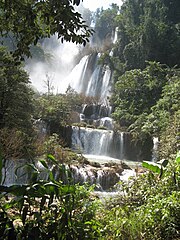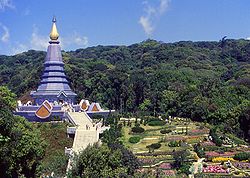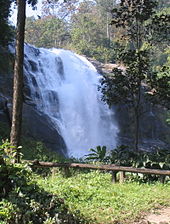The Umphang Thi Lor Sue Waterfall (also The Lor Sue, Thee Lor Sue or Te-law-zue) is claimed to be the largest and highest waterfall in Thailand. It stands 250 meters (820 ft) high and nearly 450 meters (1,480 ft) wide on the Mae Klong River, flowing down from Huai Klotho into the Umphang Wildlife Sanctuary in Tak Province in northwestern Thailand. However, the waterfall has apparently never been surveyed, as the figures given are approximate.
In fact, to be pronounced "Thee Lor Sue" and as a noun in the Karen language means "Waterfall". The name "Thi Lo Sue" is an attempt to interpret each word "Thee" or "Thi" means "water", "Lo" or "Lor" means "fall", but "Sue" has no meaning similar, so it is trying to make as meaningful as "Su" means "black", thus leading to called "Thi Lor Su" which means "black waterfall".
 Thi Lor Sue waterfall is one main reason people travel to Umphang. It is the largest waterfall of Thailand, containing many smaller drops combined together for a magnificent view. Its height is about 200 meters and total width is about 400 meters. It is most beautiful during rainy season from June to November because of the larger water flow. However during this period, the road access to the waterfall is closed for safety reason and some hiking is required. The peak season for tourism is in December and January where the water level is still high and the road to waterfall (25 km) is open for public. Only cars with four wheel drive can pass this steep and slippery road. An alternative way to reach the waterfall is by whitewater rafting downstream along the calm section of Klong River and then continue journey either on foot or by car for another about 12 km. Travelling this way, two waterfalls dropping into Klong River will be seen: Thi Lo Jo Waterfall (Thai: น้ำตกทีลอจ่อ), and Sai Rung Waterfall (Thai: น้ำตกสายรุ้ง). The name Thi Lo Sue, in Karen language, means giant waterfall or black waterfall.
Thi Lor Sue waterfall is one main reason people travel to Umphang. It is the largest waterfall of Thailand, containing many smaller drops combined together for a magnificent view. Its height is about 200 meters and total width is about 400 meters. It is most beautiful during rainy season from June to November because of the larger water flow. However during this period, the road access to the waterfall is closed for safety reason and some hiking is required. The peak season for tourism is in December and January where the water level is still high and the road to waterfall (25 km) is open for public. Only cars with four wheel drive can pass this steep and slippery road. An alternative way to reach the waterfall is by whitewater rafting downstream along the calm section of Klong River and then continue journey either on foot or by car for another about 12 km. Travelling this way, two waterfalls dropping into Klong River will be seen: Thi Lo Jo Waterfall (Thai: น้ำตกทีลอจ่อ), and Sai Rung Waterfall (Thai: น้ำตกสายรุ้ง). The name Thi Lo Sue, in Karen language, means giant waterfall or black waterfall. Thi Lor Jo or Falling Rain waterfall is approximately 3 km from Umphang. The waterfall is divided into 2 tiers. The upper falls are located on a high cliff and the tier is narrow whereas the lower falls are part of the stream of the Klong River, falling like rain fall. It is possible to travel all year-round. It is only recently that Thi Lo Le Waterfall (Thai: น้ำตกทีลอเล) is promoted as an attraction for those who prefer adventure. It is a waterfall dropping directly into Klong River located deep in Thungyai Naresuan Wildlife Sanctuary with no road access. Only traveling with tour companies is possible. The journey to the waterfall typically involves white water rafting along Klong River of about 40 km through rapids of Class 4 or 5 while the journey back is usually by riding elephants. The trip takes 2 or 3 days.
Thi Lor Jo or Falling Rain waterfall is approximately 3 km from Umphang. The waterfall is divided into 2 tiers. The upper falls are located on a high cliff and the tier is narrow whereas the lower falls are part of the stream of the Klong River, falling like rain fall. It is possible to travel all year-round. It is only recently that Thi Lo Le Waterfall (Thai: น้ำตกทีลอเล) is promoted as an attraction for those who prefer adventure. It is a waterfall dropping directly into Klong River located deep in Thungyai Naresuan Wildlife Sanctuary with no road access. Only traveling with tour companies is possible. The journey to the waterfall typically involves white water rafting along Klong River of about 40 km through rapids of Class 4 or 5 while the journey back is usually by riding elephants. The trip takes 2 or 3 days.Some other places of interests are Ta Ko Bi Cave (Thai: ถ้ำตะโค๊ะบิ), a cave formerly used by Communist Party of Thailand; Doi Hua Mot (Thai: ดอยหัวหมด), view point above cloud attitude; Ban Pa La Ta (Thai: บ้านปะละทะ), a Karen village dated back to over 250 years ago.
The rafting route begins from Ban Palata, follow the smooth flowing stream for approximately an hour. The first point is where the upper stream meets, Huai Klotho that come from Thi Lor Sue waterfall, that pass Ban Klotho. The banks of the river are full of green mountain forest. In some place, there are high mountain ranges stretching from Phawatu Mountain Range. The first rapid to be seen are Kaeng Lekati that are divided into 3 parts and extend for many kilometers. There are large rocks obstructing small river basin. The rapid that are the most difficult is Lekati 2.
Below the rapid, there is a narrow sand bank where it is possible to rest. From there, follow the river past a small waterfall on the right hand side surrounded by high cliff. Continuing on, there is an overhang that looks like a person’s face. The top is known as Phakhonmong. On the lower side is a stream that became a large set of rapids that is full of meanders.
 There are also large rocks known a Kaeng Khonmong that are divided into 3 parts. There will be a wide river basin that has a large sandy bank. Continuing on, there are known large rapids and the river flows continuously onto the month of Huai Kachochita also known as Elephant Running Creek. There is an island in front of this area, which is suitable for camping overnight. After this is Kaeng Kachochile. Passing this, there is a large open space where the water flows toward a cliff resembling a cave on the edge of the river. A large waterfall tumbles down and there are vines and other plants hanging onto the cliff side. Ferns adorn the top of the limestone cliff. This is Thi Lor Lay waterfall, the final destination on the rafting route.
There are also large rocks known a Kaeng Khonmong that are divided into 3 parts. There will be a wide river basin that has a large sandy bank. Continuing on, there are known large rapids and the river flows continuously onto the month of Huai Kachochita also known as Elephant Running Creek. There is an island in front of this area, which is suitable for camping overnight. After this is Kaeng Kachochile. Passing this, there is a large open space where the water flows toward a cliff resembling a cave on the edge of the river. A large waterfall tumbles down and there are vines and other plants hanging onto the cliff side. Ferns adorn the top of the limestone cliff. This is Thi Lor Lay waterfall, the final destination on the rafting route.
























